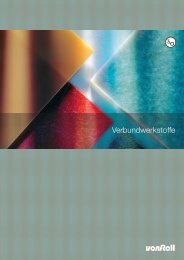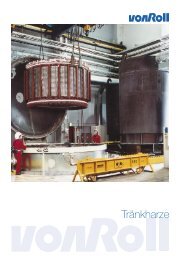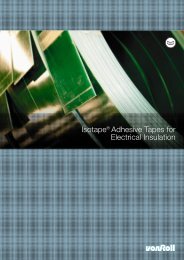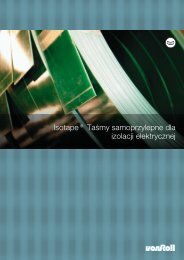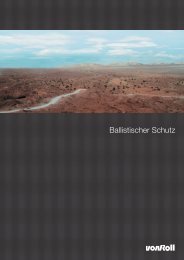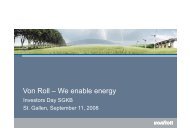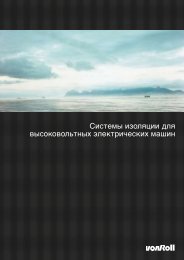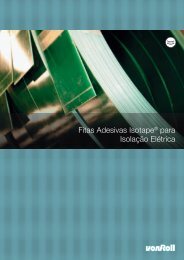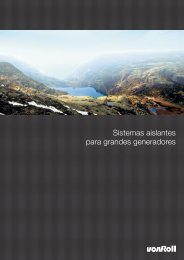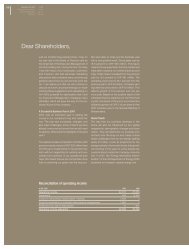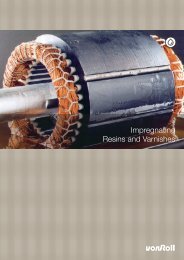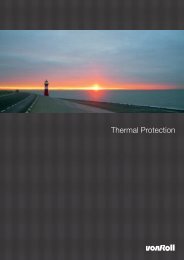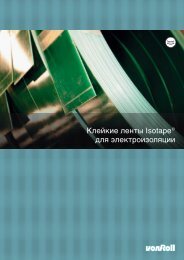Cablosam® Samica® tapes for fire-resistant cables - Von Roll
Cablosam® Samica® tapes for fire-resistant cables - Von Roll
Cablosam® Samica® tapes for fire-resistant cables - Von Roll
Create successful ePaper yourself
Turn your PDF publications into a flip-book with our unique Google optimized e-Paper software.
Cablosam ®<br />
Samica ® <strong>tapes</strong> <strong>for</strong><br />
fi re-<strong>resistant</strong> <strong>cables</strong>
Cablosam ® - Samica ® <strong>tapes</strong> <strong>for</strong> fi re-<strong>resistant</strong> <strong>cables</strong><br />
New technologies require a wide range of electrical and/or electronic functions<br />
and this means a drastic increase in the demand <strong>for</strong> <strong>cables</strong> of all types – power<br />
transmission, communication, multicore and others.<br />
Safety requirements in the modern world have increased signifi cantly and<br />
electrical appliances and installations need to function reliably even in the most<br />
testing environments, such as fi res. An oil plat<strong>for</strong>m is an artifi cial environment that<br />
depends on electrical functions at all times. Electrical integrity has to be assured<br />
whenever a fi re – even only a small one – occurs, otherwise lives, material and the<br />
environment are at risk<br />
By developing and producing of state-of-the-art Cablosam ® <strong>tapes</strong> <strong>for</strong> the<br />
manufacture of fi re-<strong>resistant</strong> <strong>cables</strong>, <strong>Von</strong> <strong>Roll</strong> is making an important contribution<br />
to disaster prevention. Our mica Cablosam ® products are in service worldwide<br />
and have been developed <strong>for</strong> use with our customers’ <strong>cables</strong> and to comply with<br />
a variety of standards.<br />
Legislation<br />
The legislation governing safety <strong>cables</strong> is extensive. Norms follow national, regional<br />
or international standards <strong>for</strong> different levels of protection and cable design. The<br />
levels of protection can be classifi ed as follows:<br />
FLAME-RETARDANT<br />
These <strong>cables</strong> make sure that fl ames go out by themselves<br />
FIRE-RETARDANT<br />
These <strong>cables</strong> ensure that fi res do not propagate, but do not assure circuit<br />
integrity.<br />
FIRE RESISTANCE<br />
These <strong>cables</strong> must ensure circuit integrity during specifi ed fi re conditions.<br />
Cablosam ® is a major contribution to this type of cable.<br />
SMOKE EMISSION<br />
Regulations concerning smoke levels<br />
EMISSION OF CORROSIVE AND TOXIC GASES<br />
Regulations concerning the agressivity and chemistry of the possible toxic<br />
gases.<br />
The norms governing fi re-<strong>resistant</strong> <strong>cables</strong> are numerous and their scope varies<br />
from regional to international. Some of the most important European standards<br />
have worldwide signifi cance.
Standards<br />
IEC 60331 FIRE TEST - INTERNATIONAL STANDARDS<br />
This norm provides <strong>for</strong> different <strong>fire</strong> tests; they all relate to IEC 60331, which covers tests <strong>for</strong> electrical <strong>cables</strong> under <strong>fire</strong><br />
conditions (circuit integrity).<br />
The differences are:<br />
IEC 60331 – 11 relates to <strong>fire</strong> alone and a flame temperature of 750°C<br />
IEC 60331 – 12 relates to <strong>fire</strong> alone and a flame temperature of 850°C<br />
IEC 60331 – 21<br />
IEC 60331 – 23<br />
IEC 60331 – 25<br />
IEC 60331 – 31<br />
relates to <strong>cables</strong> up to and including 0.6kV/1.0 kV<br />
relates to data transmission <strong>cables</strong><br />
relates to optical fibre <strong>cables</strong><br />
relates to <strong>fire</strong> with shock <strong>for</strong> <strong>cables</strong> up to and including 0.6kV/1.0 kV<br />
Please note that norm NEK 606 – Cables <strong>for</strong> offshore installations, halogen-free and/or mud-<strong>resistant</strong> – uses the IEC <strong>fire</strong><br />
norms 60331 – 11 / 21 / 25.<br />
BS 6387 / BS 8434 / EN 50200 - BRITISH AND EUROPEAN FIRE-RESISTANT STANDARDS<br />
These standards define the per<strong>for</strong>mance of electric <strong>cables</strong> when subjected to <strong>fire</strong> conditions including <strong>fire</strong> with water<br />
spray and <strong>fire</strong> with mechanical shock. The latest standards in this area are the BS 8434 standards, which are identical<br />
to the EN 50200 standards.<br />
BS 6387 Cat. C<br />
BS 6387 Cat. W<br />
BS 6387 Cat. Z<br />
EN 50200 PH 30<br />
EN 50200 PH 120<br />
950°C <strong>for</strong> 3 hours<br />
650°C <strong>for</strong> 15 minutes then 650°C with water <strong>for</strong> a further 15 minutes<br />
950°C <strong>for</strong> 15 minutes then 950°C with mechanical shock <strong>for</strong> a further 15 minutes<br />
830 °C <strong>for</strong> 15 minutes then 830°C with simultaneous water and shock <strong>for</strong> a further 15 minutes<br />
(Similar to BS 8434).<br />
930°C <strong>for</strong> 15 minutes then 930°C with simultaneous water and shock <strong>for</strong> a further 15 minutes<br />
(similar to BS 8434)<br />
DIN 4102 PART 12 FUNCTIONALITY OF ELECTRIC CABLE SYSTEMS – GERMAN STANDARDS<br />
DIN 4102 part 12 tests <strong>cables</strong> in conjunction with cable trays and clamps used in real-life applications. The specimens<br />
are mounted in the test chamber and supported by the structures provided <strong>for</strong> this purpose or fastened to the ceiling<br />
or wall in order to simulate real-life applications. The temperatures may be as high as 1050°C; the voltage test is 380 V<br />
<strong>for</strong> power <strong>cables</strong> and 110 V <strong>for</strong> communication <strong>cables</strong>. The test applies the following classifications, depending on the<br />
measured duration of circuit integrity (no short circuit and no interruption of current)<br />
E 30<br />
E 60<br />
E 90<br />
> 30 minutes<br />
> 60 minutes<br />
> 90 minutes<br />
AUSTRALIAN STANDARD<br />
The above represent some of the standards that are applied to <strong>fire</strong>-<strong>resistant</strong> <strong>cables</strong>. Other countries have even more<br />
stringent requirements, some of the most difficult being the Australian standard. This requires 120 minutes at 1030°C<br />
followed by a mechanical test and a water spray. Circuit integrity is to be maintained at all times.
The Cablosam ® product range<br />
The Cablosam ® product range consists of mica <strong>tapes</strong> which enable cable<br />
manufacturers to meet the most demanding standards.<br />
Cablosam ® <strong>tapes</strong> are made of Samica ® mica paper, a support of glass fabric<br />
or polyethylene films and silicone resin.<br />
Cablosam ® <strong>tapes</strong> are free from halogens and hazardous fumes.<br />
Cablosam ® <strong>tapes</strong> withstand mechanical pressure at high temperatures.<br />
Cablosam ® <strong>tapes</strong> provide a reliable flame barrier within the survival <strong>cables</strong>.<br />
Two types of Samica ® paper, with muscovite or phlogopite mica, are used <strong>for</strong><br />
Cablosam ® <strong>tapes</strong>. This alumino-silicate mineral retains its laminar structure up<br />
to its melting point of 1200 to 1300°C and thus ensuring that the <strong>tapes</strong> have<br />
outstanding <strong>fire</strong>-<strong>resistant</strong> properties. The difference between the two types of<br />
mica is to be found in their chemical composition and calcination characteristics;<br />
muscovite releases small amounts of water above 600°C and phlogopite above<br />
800°C.<br />
When exposed to <strong>fire</strong>, Cablosam ® <strong>tapes</strong> fuse to each other and to the copper<br />
conductor, <strong>for</strong>ming a mechanically <strong>resistant</strong> and electrical insulating layer. This<br />
layer is then responsible <strong>for</strong> maintaining electrical integrity during a <strong>fire</strong>.<br />
The following graph shows the breakdown time of two <strong>cables</strong> with the same<br />
design, one with phlogopite and one with muscovite.<br />
BREAKDOWN TIME FOR TWO IDENTICAL CABLE DESIGNS<br />
Phlogopite HP<br />
with glass<br />
Min<br />
33 minutes<br />
Max<br />
72 minutes<br />
Muscovite HP<br />
with glass<br />
Min<br />
44 minutes<br />
Max<br />
89 minutes<br />
0 10 20 30 40 50 60 70 80 90<br />
minutes<br />
The Cablosam ® product range comprises two families:<br />
Cablosam ® HP<br />
These “high-per<strong>for</strong>mance” products are used to meet the most demanding<br />
requirements. They achieve this by virtue of their optimal material composition<br />
and specific advantages.<br />
Our muscovite tape 366.21-10 is particularly soft thanks to the special mica paper<br />
used.<br />
Cablosam ® AP<br />
“All-purpose” products are designed <strong>for</strong> applications where cost is a major<br />
factor.
All of our Cablosam ® <strong>tapes</strong> are literally “joint-free”, i.e. the joints are so strong and<br />
so thin that they are almost invisible and do not affect the characteristics of the<br />
tape.<br />
Product<br />
Cablosam ® HP<br />
Total weight<br />
(gr/m 2 )<br />
Thickness<br />
(mm)<br />
Samica<br />
(gr/m 2 )<br />
Support Samica ®<br />
Cablosam ® HP 366.21-10 130 ± 11 0.12 ± 0.02 75 Glass fabric Special muscovite<br />
Cablosam ® AP<br />
Cablosam ® AP MPE80 120 ± 10 0.08 ± 0.02 80 Polyethylene film Muscovite<br />
Cablosam ® AP PPE80 120 ± 10 0.08 ± 0.02 80 Polyethylene film Phlogopite<br />
Cablosam ® AP PPE110 162 ± 10 0.11 ± 0.02 120 Polyethylene film Phlogopite<br />
Cablosam ® AP PPE130 206 ± 18 0.13 ± 0.02 160 Polyethylene film Phlogopite<br />
Cablosam ® AP MG90 120 ± 10 0.09 ± 0.02 80 Glass fabric Muscovite<br />
Cablosam ® AP PG90 120 ± 10 0.09 ± 0.02 80 Glass fabric Phlogopite<br />
Cablosam ® AP PG110 161 ± 12 0.11 ± 0.02 120 Glass fabric Phlogopite<br />
Cablosam ® AP PG130 170 ± 13 0.13 ± 0.02 120 Glass fabric Phlogopite<br />
Processing<br />
Cablosam ® <strong>tapes</strong> are applied to stranded wires, conductors and <strong>cables</strong> by stripwinding<br />
machines in one or more tangentially or radially overlapping layers. The<br />
<strong>tapes</strong> have to be applied with the glass fabric facings outwards and the mica paper<br />
inwards, against the conductor. To join the ends of pads or cross wound spools<br />
during production, we recommend our Isotape ® 51594 or Isotape ® 51587.<br />
Conductors, stranded wire or <strong>cables</strong> insulated in this manner can then be covered<br />
with thermoplastic material to <strong>for</strong>m the final product. The dust-repellent properties<br />
of the <strong>tapes</strong> prevent the extrusion nozzle from clogging.<br />
Perfect de-rolling of the spools. No deflection of wire during taping. Taping cross wound spools with state of the art<br />
machines.
Delivery <strong>for</strong>m<br />
<strong>Von</strong> <strong>Roll</strong> offers customers:<br />
Cablosam ® <strong>tapes</strong> from widths of 4 mm upwards as pads or cross-wound<br />
spools. The length of the pads depends on the width of the material required to<br />
ensure correct stability and may be in excess of 1200 m.<br />
Cross-wound spools may be up to 20 km in length depending on the width and<br />
dimensions of the spool. Used in conjunction with a suitable taping machine,<br />
spools can be extremely cost-effective, since they allow a very high level of<br />
autonomy.<br />
Cablosam ® taped conductors on bare or tinned single or stranded wires can<br />
be produced to customer specifications.<br />
Examples of such specifications include:<br />
Product<br />
Tape used<br />
Overlap<br />
(%)<br />
Increase in insulation<br />
(mm)<br />
Cablosam ® SK 735 366.21-10 25 to 35 0.36<br />
Cablosam ® SK 135 366.21-10 25 to 35 0.38<br />
Cablosam ® SK 150 366.21-10 40 to 50 0.4<br />
Cablosam ® 2 SK 735 366.21-10 25 to 35 0.7<br />
REGULAR PADS<br />
CROSS-WOUND SPOOLS
Cablosam ® applications<br />
Fires can occur anywhere, but their effects can be particularly hazardous wherever<br />
large numbers of people are gathered together, where safety-related equipment<br />
is in use or in environments where there is a particularly high fi re risk. In such fi re<br />
conditions, vital in<strong>for</strong>mation and functions need to be maintained, and power and<br />
signal <strong>cables</strong> have to be adequately protected <strong>for</strong> a predefi ned period of time.<br />
Fire-<strong>resistant</strong> <strong>cables</strong> are used in a variety of installations such as:<br />
• Offshore oil rigs<br />
• Multi-storey buildings<br />
• Power stations<br />
• Industrial plants<br />
• Subways<br />
• Computer centres<br />
• Aerospace units<br />
• Telecommunication centres<br />
• Ships<br />
• Military facilities<br />
The types of <strong>cables</strong> used vary widely and are manufactured to customers’<br />
specifi cations. They can be described by application:<br />
• Power <strong>cables</strong><br />
• Multicore <strong>cables</strong><br />
• Data <strong>cables</strong><br />
• High-frequency <strong>cables</strong><br />
• Communication <strong>cables</strong><br />
Examples<br />
The fi gure below shows two types of <strong>cables</strong>: one <strong>for</strong> maximum requirements,<br />
in which every single wire is individually insulated, and a second featuring core<br />
insulation to protect against cable breakdown.<br />
1 3 5<br />
FOR MAXIMUM REQUIREMENTS<br />
1 2 4 5<br />
AS CORE INSULATION AGAINST BREAKDOWN<br />
1 Copper conductor / 2 Insulation / 3 Cablosam ® as fl ame barrier / 4 Cablosam ® as fl ame and heat barrier / 5 Sheath
<strong>Von</strong> <strong>Roll</strong> Switzerland Ltd • CH-4226 BREITENBACH<br />
www.vonroll.com<br />
All in<strong>for</strong>mation in this document is subject to the product liability clause as published in the Website www.vonroll.com under legal in<strong>for</strong>mation.<br />
Creation : www.zygmund.fr • Photos of products : Marc Barral-Baron • 04/2006



